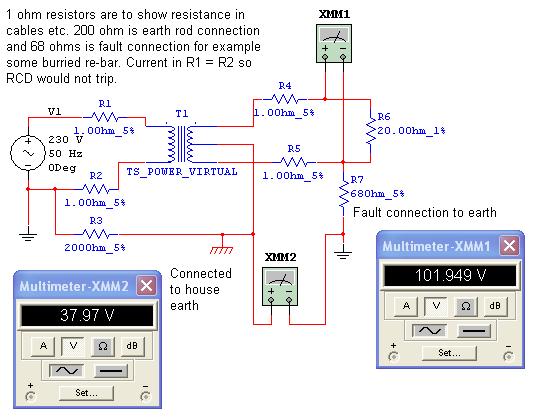When we assess fault characteristics for an RLVS, or a normal installation, we are generally concerned with faults between the line conductor (R1) and an exposed-conductive-part. This exposed-conductive-part is usually connected to the main earth terminal via a circuit protective conductor (R2).
Faults (zero impedance) between line conductors and extraneous-conductive-parts, such as your gas pipe, are far less likely, and are not generally considered. They could be, but we would need to know the impedance of the extraneous-conductive-part between the point of fault and the point of any connection to the main earth terminal. Extraneous-conductive-parts are therefore not generally included in the earth fault loop path.
So when you assess the touch voltage (Ut) for an RLVS you are concerned with the impedance of the transformer winding, the impedance of the line conductors and the impedance of the circuit protective conductor. The transformer earth reference electrode is not included in the fault current path. It does, however, provide the earth reference, and would provide a path for the touch current (It). This is the body current that actually gives the shock - see BS EN 60990:2000.
So as I said in my last post - you need superposition theorem and about ten pages of circuit analysis

.
The principle is to consider the transformer secondary as two 55 volt circuits consisting of a line conductor and a circuit protective conductor (cpc). Various faults are applied both near the transformer and far from it (i.e. at the end of a final circuit). This is done for each 55 volt circuit and the results are superimposed to complete the analysis - its too complex to describe in detail, but the general idea is straightforward. This is also carried out for the three phase version.
Check out HSE guidance on the 110 volt system - somewhere in that you will see the 40 volt figure mentioned, and Paul Cook correctly quotes 30 volts on page 84 of his Commentary.
Ericmark said
As to Section 704 I did not quote from this section I gave 411.8.3 as my reference so the 5 second disconnection time is not anything to do with BS 7375.
Its all part of BS 7671. The point here is that the standards adopt different approaches and actually end up in disagreement.
BS 7671 follows the traditional route of specifying a 5 second disconnection time, but this ignores the fact that Ut is less than 50 volts, and therefore, disconnection in any specified time is not essential for shock protection.
So why make a fuss - well if you insist on a disconnection time you end up imposing an impedance limit on the circuit. That is, the impedance must be low enough to operate an overcurrent protective device. The usual alternative would be to use an RCD but let's leave that option at the moment.
A limit on impedance imposes a limit on circuit length and, from memory, you end up restricting the length of a 1.5mm² extension lead to around 16 metres. Now, as Eric has pointed out, leads get plugged into leads and any limits are ignored

.
RCDs - IMO they are just not robust enough to be housed in a portable transformer for use on site. In
addition they add nothing to a system that, from the shock protection point of view, is inherently safe.



